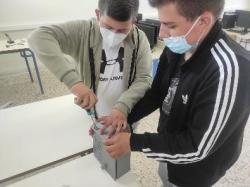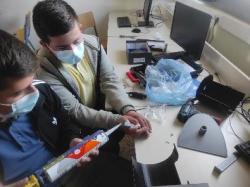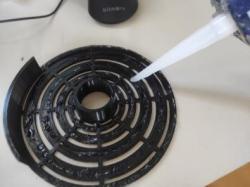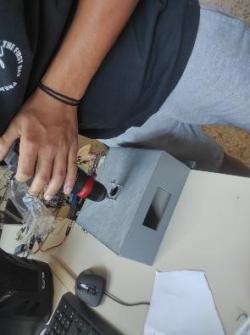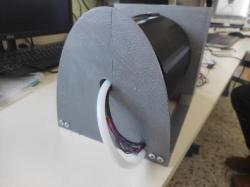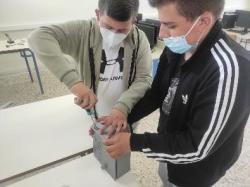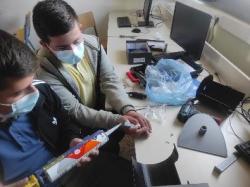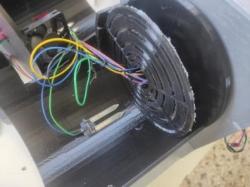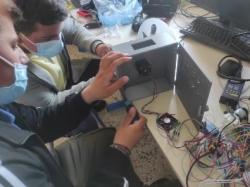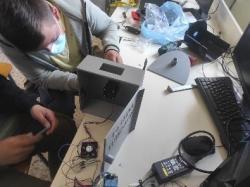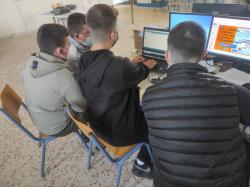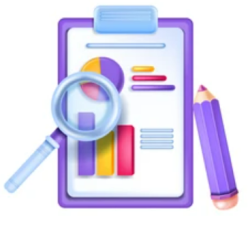Hosted by SALL , contributed by ggidas on 7 July 2022
Composting is a part of the Circular Economy and helps to reduce the effect of Climate Change. Encouraging the use of composting systems by communities, municipalities, regions, private bodies and citizens in general is considered necessary, especially in the times we are living in.
Our Smart composting system through sensors will record internally: Compost mix moisture, Air humidity, Air temperature, Methane levels.
Depending on the values, a ventilation system, a system to increase the humidity inside and a motor that moves the contents of the compost bin will be activated. All these values will display on the screen present in our construction.
Background
Our school has been actively involved the last 6 years in robotics and STEAM technologies. The students with the support of their teachers have managed to create impressive and innovative projects impressing and winning awards. A virtual tour of the Robotics and Innovation Lab and our projects is available at the website https://1epal-trikal.tri.sch.gr/draseis/mnae/.
Before starting the implementation of this project we dealt with the principles and practices of Citizen Science. When the idea of composting came up, we researched and created an online questionnaire related to the circular economy and composting on the behavior and opinions of students and citizens of our city. The most important results obtained from the questionnaire are reported in the video located on the website https://youtu.be/cvGBoXvN4oI. Detailed answers to the questionnaires can be seen in the following images.
Initially, we studied the existing situation around composting by obtaining information from the internet and from books as well as communication with competent a. We found that a composting system can minimize or even eliminate waste at all stages of production, but also after the end of the products' life cycle. The main aim is to encourage the use of secondary materials and waste as productive resources and useful materials, giving the dimension of sustainability to the production model.




Aim
The purpose was the creation of an innovative project by students of the 1st and 2nd grade EPAL that covers the needs and interests of the students and the local community.
The aim was:
- The utilization of the inclinations of the students and their creative expression, the intellectual cultivation, the integration of the personality of each student, as well as the cooperation between the members of the school community
- Raising students' awareness of issues of social and environmental interest while simultaneously developing a collective spirit of cooperation
- The perception of contemporary and real problems through communication with local actors
- The development of students' critical thinking, collective effort and experiential action through activities
- The creation of a pleasant and creative environment, where learning and teaching are not treated as passive acceptance of piecemeal knowledge

Co-creation with societal actors
We had two (2) teleconferences with the special partners of the Municipality of Trikala Mrs. Konstantina Zahari and Mr. Georgios Chrysomallos respectively.
In the 1st teleconference the students were informed about the installation of an integrated circular economy system for urban vegetable gardens in Trikala. A program that aims to involve citizens in the effort to reduce the environmental footprint. This particular system consists of 4 parts: a) the integrated compost bin, b) the rainwater collector, c) the integrated crop planting area and d) the smart garden and compost management system.
By using this system, the Municipality of Trikala and Trikala's citizens will have significant benefits, such as:
- Reducing the amount of water used from the water supply network
- Reduction in commercial fertilizer use
- Reduction of water use for production
- Increase in the amount of vegetables produced
- Reduction of production costs
- Reducing the amount of waste

In the 2nd teleconference the students get informed about circular economy issues. A special mention was made of automated systems used by the Municipality of Trikala that make our city the most innovative smart city in Greece.


Teleconference with Mr. Georgios Chrysomallos
After the important and interesting informations, the students decided to create their own system for smart composting to help implement a circular economy in our Municipality.
Implementation
After studying the existing situation around composting by gathering information from the internet, from books as well as from communication with the special collaborators of the Municipality of Trikala, we found that a composting system can minimize or even eliminate waste at all stages of production, but and after the end of the products life cycle. The main aim is to encourage the use of secondary materials and waste as productive resources and useful materials, giving the dimension of sustainability to the production model.
We created a Smart composting system, which will measure through sensors inside it:
- Compost mix moisture
- Air humidity
- Air temperature
- Methane levels
Depending on the values, a ventilation system, a system to increase the humidity inside and a motor that moves the contents of the compost bin are activated. All these values are shown on the LCD in our construction.
We didn’t find a similar smart composting system either in the Greek or foreign market. For its implementation we used Open Technologies through an Arduino circuit, the Internet of Things and 3D printing.
The materials we used were:
- A Funduino Mega2560
- A Breadboard
- A LCD Screen - RGB I2C
- An I2C BME280 Temperature/Humidity/Barometric Pressure Sensor
- A CNG Methane Sensor - MQ-4
- A 2-position Relay
- A water pump
- A fan
- A 4.5kg Stepper Motor with A4988 Driver
- Cables to interconnect all of these and
- Filament for 3D printing
The cost of all this amounted to €150.
The layout of the circuit we created is shown in the image below
The design of the circuit was made taking into account what we discovered from the research we carried out. At first we saw the operation of each sensor and actuation system separately, but in the end we put it all together.
The entire circuit was placed in a compost bin that we designed in TinkerCad and printed on our school's 3D printer
Reflection
The students' construction was presented in our school auditorium to students, teachers and parents.

